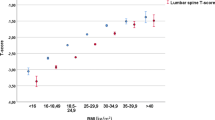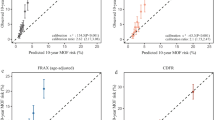Abstract
Summary
In an observational study population of 62,413 individuals (6,455 [10 %] with diabetes), diabetes was independently associated with major osteoporotic fractures (MOFs) but did not significantly modify the effect of FRAXTM risk factors or prior fracture site. However, the presence of diabetes exerted a much stronger effect on hip fracture risk in younger versus older individuals.
Introduction
Diabetes mellitus increases fracture risk independent of risk factors that comprise the WHO FRAXTM tool. We explored whether diabetes modifies the effect of FRAX clinical risk factors on MOF and hip fracture risk.
Methods
Using a registry of clinical dual-energy X-ray absorptiometry (DXA) results for Manitoba, Canada, we identified women and men aged 40 years and older undergoing baseline DXA in 1996–2011. Health services data were used to identify diabetes diagnosis, FRAX risk factors and incident fractures using previously validated algorithms. Prior fracture was stratified as clinical vertebral, hip, humerus, forearm, pelvis and ‘other’. Cox proportional hazards models were used to test for statistical interactions of diabetes with FRAX clinical risk factors and prior fracture site.
Results
During a mean follow-up of 6 years, there were 4,218 MOF and 1,108 hip fractures. Diabetes was a significant independent risk factor for MOF adjusted for FRAX risk factors including bone mineral density (BMD) (adjusted hazard ratio [aHR] 1.32 [95 % confidence interval (CI) 1.20–1.46]). No significant interactions of FRAX risk factors or prior fracture site with diabetes were identified in analyses of MOF. For predicting hip fractures, age significantly modified the effect of diabetes (aHR age <60, 4.67 [95 % CI 2.76–7.89], age 60–69, 2.68 [1.77–4.04], age 70–79, 1.57 [1.20–2.04], age >80, 1.42 [1. 10–1.99]; pinteraction <0.001).
Conclusions
Diabetes is an independent risk factor for MOFs and does not significantly modify the effect of FRAX risk factors or prior fracture site. However, diabetes exerts a much stronger effect on hip fracture risk in younger than older individuals which needs to be considered in hip fracture prediction.

Similar content being viewed by others
References
van Staa TP, Dennison EM, Leufkens HG et al (2001) Epidemiology of fractures in England and Wales. Bone 29:517–522
Blanchard JF, Ludwig S, Wajda A et al (1996) Incidence and prevalence of diabetes in Manitoba, 1986-1991. Diabetes Care 19:807–811
Wild S, Roglic G, Green A et al (2004) Global prevalence of diabetes: estimates for the year 2000 and projections for 2030. Diabetes Care 27:1047–1053
Strotmeyer ES, Cauley JA, Schwartz AV et al (2005) Nontraumatic fracture risk with diabetes mellitus and impaired fasting glucose in older white and black adults: the health, aging, and body composition study. Arch Intern Med 165:1612–1617
Janghorbani M, Feskanich D, Willett WC et al (2006) Prospective study of diabetes and risk of hip fracture: the Nurses’ Health Study. Diabetes Care 29:1573–1578
Janghorbani M, Van Dam RM, Willett WC et al (2007) Systematic review of type 1 and type 2 diabetes mellitus and risk of fracture. Am J Epidemiol 166:495–505
De Liefde II, Van Der KM, de Laet CE et al (2005) Bone mineral density and fracture risk in type-2 diabetes mellitus: the Rotterdam Study. Osteoporos Int 16:1713–1720
Hanley DA, Brown JP, Tenenhouse A et al (2003) Associations among disease conditions, bone mineral density, and prevalent vertebral deformities in men and women 50 years of age and older: cross-sectional results from the Canadian Multicentre Osteoporosis Study. J Bone Miner Res 18:784–790
Bonds DE, Larson JC, Schwartz AV et al (2006) Risk of fracture in women with type 2 diabetes: the Women’s Health Initiative Observational Study. J Clin Endocrinol Metab 91:3404–3410
Melton LJ III, Riggs BL, Leibson CL et al (2008) A bone structural basis for fracture risk in diabetes. J Clin Endocrinol Metab 93:4804–4809
Giangregorio LM, Leslie WD, Lix LM et al (2012) FRAX underestimates fracture risk in patients with diabetes. J Bone Miner Res 27:301–308
Schwartz AV, Vittinghoff E, Bauer DC et al (2011) Association of BMD and FRAX score with risk of fracture in older adults with type 2 diabetes. JAMA 305:2184–2192
Kanis JA, Oden A, Johansson H et al (2009) FRAX and its applications to clinical practice. Bone 44:734–743
Leslie WD, Rubin MR, Schwartz AV et al (2012) Type 2 diabetes and bone. J Bone Miner Res 27:2231–2237
Leslie WD, Metge C (2003) Establishing a regional bone density program: lessons from the Manitoba experience. J Clin Densitom 6:275–282
Leslie WD, Caetano PA, MacWilliam LR et al (2005) Construction and validation of a population-based bone densitometry database. J Clin Densitom 8:25–30
Leslie WD (2006) The importance of spectrum bias on bone density monitoring in clinical practice. Bone 39:361–368
Looker AC, Wahner HW, Dunn WL et al (1998) Updated data on proximal femur bone mineral levels of US adults. Osteoporos Int 8:468–489
Leslie WD, Lix LM, Johansson H et al (2010) Independent clinical validation of a Canadian FRAX tool: fracture prediction and model calibration. J Bone Miner Res 25:2350–2358
Klotzbuecher CM, Ross PD, Landsman PB et al (2000) Patients with prior fractures have an increased risk of future fractures: a summary of the literature and statistical synthesis. J Bone Miner Res 15:721–739
Morin SN, Lix LM, Leslie WD (2014) The importance of previous fracture site on osteoporosis diagnosis and incident fractures in women. J Bone Miner Res [Epub head of print]
WHO Collaborating Centre for Drug Statistics Methodology. (eds) (2005) Guidelines for ATC classification and DDD assignment. Oslo
Roos NP, Shapiro E (1999) Revisiting the Manitoba Centre for Health Policy and Evaluation and its population-based health information system. Med Care 37:JS10–JS14
Leslie WD, Tsang JF, Caetano PA et al (2007) Effectiveness of bone density measurement for predicting osteoporotic fractures in clinical practice. J Clin Endocrinol Metab 92:77–81
Kleinbaum DG, Klein M. (eds) (2010) Logistic regression: a self-learning text (3rd edition). Springer (New York)
Leslie WD, Lix LM, Wu X (2013) Competing mortality and fracture risk assessment. Osteoporos Int 24:681–688
Fraser LA, Pritchard J, Ioannidis G et al (2011) Clinical risk factors for fracture in diabetes: a matched cohort analysis. J Clin Densitom 14:416–421
Acknowledgments
We are indebted to Manitoba Health for providing data (HIPC File No. 2011/2012—31). The results and conclusions are those of the authors, and no official endorsement by Manitoba Health is intended or should be inferred. This article has been reviewed and approved by the members of the Manitoba Bone Density Program Committee.
Funding
None.
Conflicts of interest
SNM is chercheur-boursier des Fonds de Recherche du Québec en Santé. LML is supported by a Manitoba Health Research Chair. SRM holds the Endowed Chair in Patient Health Management (Faculties of Medicine and Dentistry and Pharmacy and Pharmaceutical Sciences, University of Alberta) and receives salary support as a Health Scholar of the Alberta Heritage Foundation for Medical Research and Alberta Innovates-Health Solutions. William Leslie is a speaker bureau (paid to facility) of Amgen, Eli Lilly, and Novartis and has research grants (paid to facility) from Amgen, Genzyme. Suzanne Morin is a consultant to Amgen, Eli Lilly, and Merck and a speaker bureau of Amgen and Eli Lilly and has a research grant from Amgen. Lisa M. Lix and Sumit R. Majumdar declare that they have no conflict of interest.
Author information
Authors and Affiliations
Corresponding author
Rights and permissions
About this article
Cite this article
Leslie, W.D., Morin, S.N., Lix, L.M. et al. Does diabetes modify the effect of FRAX risk factors for predicting major osteoporotic and hip fracture?. Osteoporos Int 25, 2817–2824 (2014). https://doi.org/10.1007/s00198-014-2822-2
Received:
Accepted:
Published:
Issue Date:
DOI: https://doi.org/10.1007/s00198-014-2822-2




